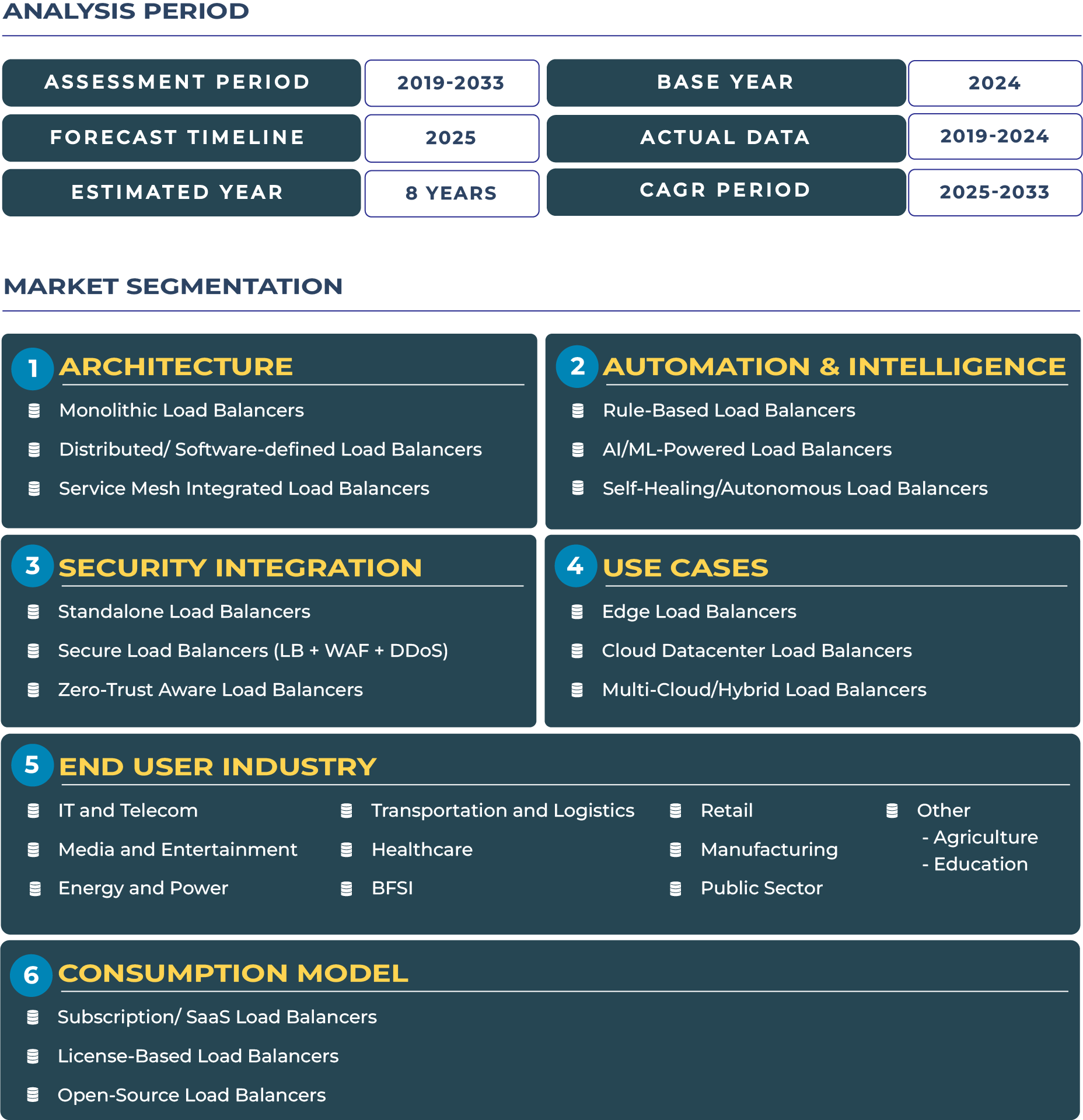Report Format:
![]()
![]() |
Pages: 110+
|
Pages: 110+
UAE as a Cloud-First Global Hub Blending Fintech, Hyperscalers, and Smart City Projects
The United Arab Emirates (UAE) has cemented its role as a global hub for digital-first economies, where smart city projects, fintech adoption, and hyperscaler expansions converge to define the future of cloud infrastructure. With forward-looking initiatives led by UAE Government on smart governance and digital innovation, the country is not only accelerating its cloud-first policies but also creating a fertile ecosystem for advanced traffic distribution and resilience tools such as cloud load balancers. These solutions form the backbone of mission-critical digital services, ensuring secure, scalable, and latency-optimized workloads across industries. As per latest data, the UAE Cloud Load Balancers Market is estimated to reach USD 14.6 million in 2025 and is projected to grow to USD 49.4 million by 2033, advancing at a CAGR of 16.4% during 2025–2033. The growth trajectory reflects the country's ambitions to transform into a global “cloud-first” destination where BFSI resilience, large-scale tourism events, and digital commerce ecosystems demand robust application delivery solutions.
UAE Cloud Load Balancers Market Outlook: Strong Performance Anchored in Smart Cities and Digital Finance
The market outlook for the UAE cloud load balancers industry is defined by its alignment with national strategies on economic diversification, digital sovereignty, and smart infrastructure deployment. Being home to financial free zones such as DIFC and ADGM, alongside mega smart city projects like Masdar City and Expo legacy zones, the country has positioned itself as a magnet for financial-grade workloads and global enterprises seeking low-latency and compliance-ready architectures. The rapid deployment of hyperscaler regions from leading players such as Microsoft Azure UAE Cloud Regions adds scale and elasticity to the local cloud ecosystem, amplifying demand for distributed and software-defined load balancers. These are critical in meeting traffic surges during high-profile tourism seasons, fintech transaction peaks, and real-time IoT applications in mobility and healthcare. The outlook remains positive as enterprises increasingly shift toward multi-cloud and sovereign frameworks, creating a vibrant landscape where distributed and service-mesh integrated load balancers play a crucial role in ensuring interoperability and continuity.
Key Drivers and Hindrances Shaping the UAE Cloud Load Balancers Landscape
One of the strongest growth drivers is the UAE’s positioning as a regional hub for cloud and finance, where demand for low-latency, secure, and resilient architectures comes from both global financial institutions and fast-scaling fintech startups. Alongside this, the expansion of hyperscaler data centers has significantly boosted cloud consumption. Local hosting capacity, advanced submarine cable routes, and sovereign cloud initiatives are enabling enterprises to deploy scalable workloads with high availability. Moreover, national ambitions around global tourism events, including Expo legacies and stadium-scale deployments for sports and entertainment, create unique demand for load balancing architectures capable of handling sudden, massive traffic influxes without compromising service quality.
However, the sector is not without challenges. Intense vendor competition places pricing pressure on solution providers, making differentiation through SLAs and vertical-specific offerings increasingly important. The high operating coststalent churn in cybersecurity and cloud engineering roles continues to affect continuity, as skilled professionals are in high demand across GCC markets. These headwinds may temporarily limit margin expansion, but the overall market momentum remains robust, driven by the region’s strategic shift toward digitized, cloud-native economies.
Emerging Trends and Opportunities in the UAE Cloud Load Balancers Ecosystem
The UAE is seeing strong adoption of finance-grade, low-latency workloads, particularly in areas such as cross-border payments, instant settlements, and blockchain-enabled trade finance. Here, distributed and software-defined load balancers are being used to maintain ultra-low latency and compliance-driven routing. Another notable trend is the use of event and stadium edge architectures, where large sporting and cultural events demand advanced application delivery strategies to ensure uninterrupted connectivity for tens of thousands of concurrent users. Sovereign cloud initiatives, where government-regulated data residency rules come into play, are pushing enterprises toward service mesh-integrated load balancers to ensure compliance with local data laws while maintaining multi-cloud flexibility.
The opportunities are equally transformative. Premium-grade load balancers tailored for BFSI and large-scale events are emerging as high-value offerings where enterprises are willing to pay for resilience and compliance. Furthermore, the growth of regional multi-cloud control planes creates opportunities for vendors to position themselves as orchestrators of hybrid and federated ecosystems. Lastly, partnerships and co-builds with telcos and data center providers enable cloud load balancer vendors to extend reach and scale faster, ensuring their services are embedded into the UAE’s wider digital transformation roadmap.
Competitive Dynamics: Premium Solutions and Local-Global Partnerships Define the Sector
The UAE cloud load balancers sector is shaped by a mix of international hyperscalers and regional ICT players. Companies such as F5 Networks are leading with premium application delivery solutions, offering advanced SLAs suited for BFSI workloads and event-driven use cases. Microsoft and AWS continue to deepen their regional presence through hyperscaler regions, integrating resilient load balancing capabilities as part of their ecosystem strategies. Local telcos, including Etisalat and du, are actively co-developing cloud-native services with distributed load balancer functionalities, targeting enterprises seeking sovereign-compliant infrastructure. Recent developments, such as regional data center expansions in Abu Dhabi and Dubai in 2024, highlight the growing emphasis on sovereign, high-performance architectures. Vendors are increasingly differentiating through compliance assurance, ultra-low-latency solutions, and partnerships with regulated sectors, as enterprises demand reliable, secure, and scalable delivery frameworks.







